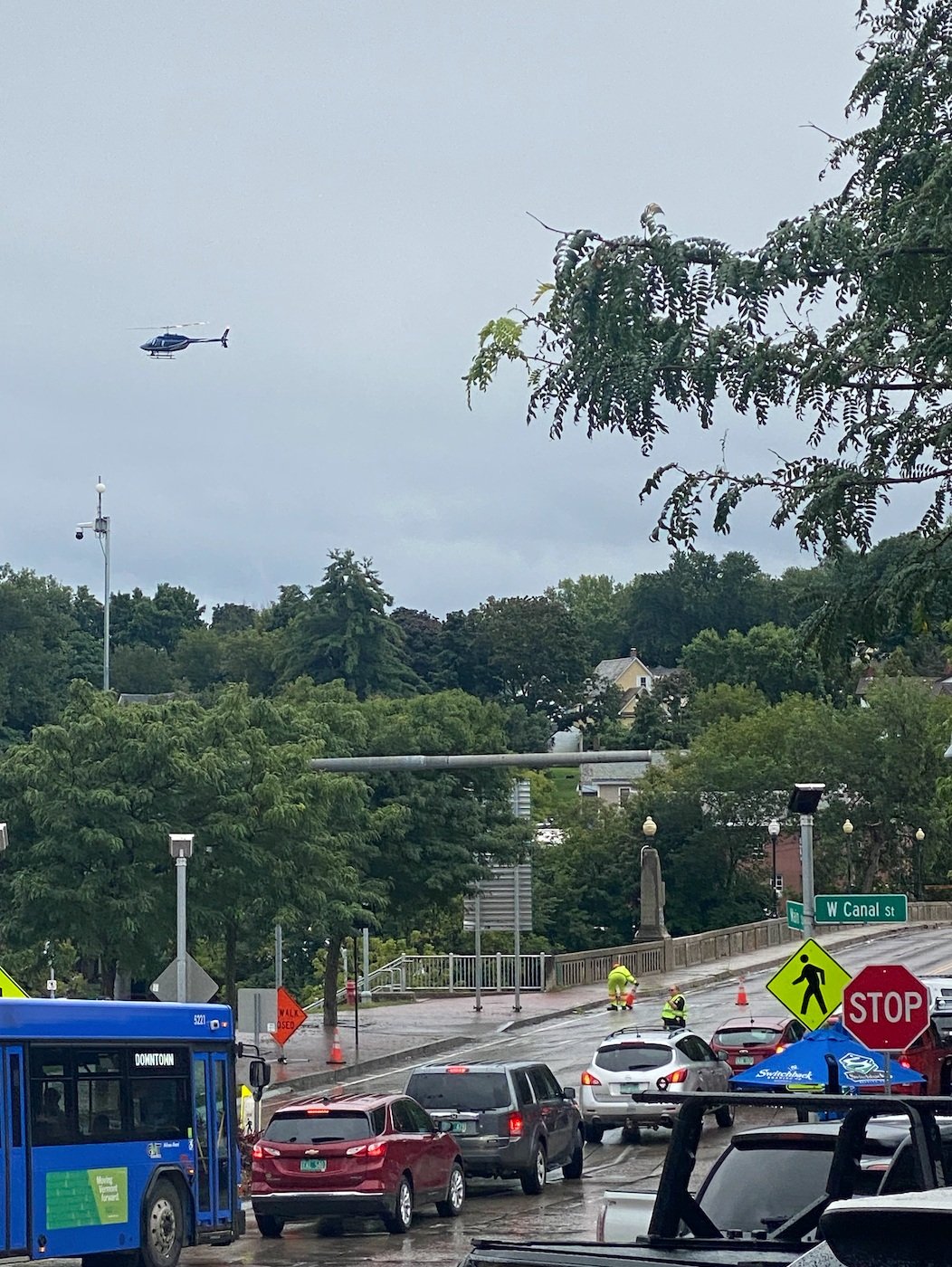Winooski and Burlington residents hear first presentation on bridge replacement project
The engineering firm that’s overseeing the upcoming replacement of the 95-year-old bridge connecting Burlington and Winooski held its first public meeting last week, inciting questions and feedback from anxious residents.
A helicopter surveys the Winooski-Burlington bridge in late August
Nearly 50 people came to the O’Brien Community Center in Winooski on Sept. 19 to hear representatives of HNTB Corp., an infrastructure design company based in Kansas City, Mo., describe details of the project. Another 45 participants joined the meeting via Microsoft Teams.
Construction of the new bridge over the Winooski River isn’t slated to begin until 2027, but anticipation of the disruption to traffic and the potential improvements for the primary link between the two cities drew widespread attention. Roughly 25,000 vehicles and 300 people on foot cross the bridge each day.
HNTB representatives are handling public outreach about the project for the Vermont Agency of Transportation and provided an overview of the project.
“There’s two focal points out there: We have the bridge itself … and we have the intersection to the south of it,” said Josh Olund, the Structures Department Manager for HNTB, who is based in South Portland, Maine. The work will include a four-way intersection on the Burlington side to replace the current A-shaped juncture, which Olund characterized as problematic. It’s confusing for drivers and unsafe for bikers and pedestrians, contributing to a history of crashes, he said during the presentation.
The update will increase each of the bridge’s four lanes by four inches, to 11 feet across, and the width of the pedestrian and bike path will double to 12 feet on both sides of the bridge. The new bridge will incorporate modern materials and building standards that will strengthen it against flooding and other weather events.
The eventual disruption to traffic is likely to create headaches for the connected cities. While the bridge is under construction, Olund said, the most efficient alternative route will take drivers to Interstate 89. Once construction starts, vehicles will have to detour for four to six weeks, according to the team, while pedestrian traffic is maintained.
Engineers plan to build a separate pedestrian-only bridge to the right of the current one while construction is ongoing. “Once that’s built and in place, we can move people over,” so they can continue to cross the bridge on foot, Olund said.
The project is estimated to cost $50 million to $60 million. About $25 million of that total has come from a Rebuilding American Infrastructure with Sustainability and Equity grant, part of a U.S. Department of Transportation program to support infrastructure projects.
Following their presentation, Olund and Jennifer Zorn, HTNB’s public information consultant based in Concord, New Hampshire, opened the floor for questions. Zorn walked down each row to hand speakers a microphone and gave online viewers a chance to ask questions in between those in person.
“We do want as many voices and as many opinions involved, and it’s a great way for people to meet their neighbors,” Zorn said.
“We want these meetings to be enjoyable.”
The next public meeting on the bridge project had not yet been scheduled as of publication time.
A common concern that arose from those in attendance was the amount of protection between faster vehicles on the bridge and people walking and biking. “It’s something that I do often with my three-year-old daughter, on the front of my bike,” said Micheal Bisogno, who works from his home in Winooski but said he uses the bridge nearly every day.
A proposed curb to separate the pedestrian path from vehicle lanes was the “bare minimum” the new bridge should have, he said, urging the state to make sure that contractors who will ultimately build the new bridge incorporate that element.
A few residents suggested a double-decker bridge, where pedestrians and bicyclists would have access to an upper platform, with a lower section exclusively for cars. While acknowledging the idea would make pedestrians feel safer, Olund said it would require funding and planning that would far exceed the current budget.
Other speakers suggested a raised sidewalk, a marsupial bridge — which has a walkway for pedestrians that is suspended off the side of the auto crossing — and a roundabout to replace the four-way intersection on the Burlington side.
Tom Derenthal, a Burlington resident and a member of the Green Mountain Transit board of commissioners, warned about potential long delays for buses using the detours during construction and suggested the transit company might need more funding to manage the additional time and travel. “The sooner that you start talking to GMT, the better,” Derenthal said.
For Burlington resident Cindy Cook, a replacement of the almost century-old river passage is long overdue, and she wondered if it would hold up as long as the project will take. Olund assured her that the bridge had passed its two-year inspections and showed no indications of being unsafe.
Still, Cook said, she considers it a risky venture. “I have a moment of gratitude after crossing the bridge.” For more information, visit burlingtonwinooskibridge.vtransprojects.vermont.gov/

